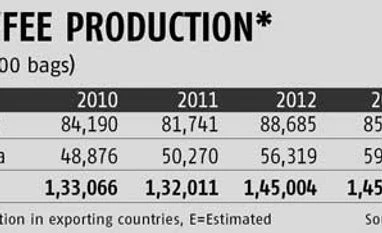Good days are ahead for coffee growers and traders as bean prices are likely to increase on the back of lower production in Brazil, a major producing country.
“Going by the indications of International Coffee Organization (ICO), which has projected a lower crop in 2014-15, we expect Arabica prices to go up 15-20 per cent by February or March next year,” said Ramesh Rajah, president, Coffee Exporters’ Association.
The Association expects Arabica prices to touch 250 cents per lb (pound), an increase of 19 per cent from the current levels of 210 cents per lb. Robusta prices are likely to touch $2,300 a tonne, about 15 per cent higher over the current levels, by the first quarter of 2015, Rajah added.
Robusta prices might not increase much, compared to Arabica. However, it is too early to make a guess as the condition in Brazil, the leading producer, keeps changing. Recent rains in that country has given hope for a better than estimated crop next year, he noted.
Prices were volatile again in September, mostly reacting to weather news from Brazil. Daily prices fell initially but rose towards the end of the month as reports of dryness in Brazil exacerbated concerns over next year’s crop, ICO said.
A new survey from Conab, the Brazilian crop forecasting agency, gave a revised production estimate of 45.14 million bags for crop year 2014-15 (April to March), around 570,000 bags (each bag is 60 kg) higher than the previous estimate. This new estimate leaves production in Brazil in 2014-15 at its lowest level since 2011-12, with mounting concerns over the 2015-16 crop.
Crop year 2013-14 has ended in all exporting countries, with total production estimated at 145.2 million bags, unchanged on the previous year. World consumption was also around 145 million bags in calendar year 2013, leaving the market reasonably balanced, but lower production expected in 2014-15 will likely result in a global deficit next year, ICO said.
A slight recovery is expected in parts of Central America during crop year 2014-15, as the damage from coffee leaf rust is starting to subside. Nevertheless, the social and economic damage to the region is ongoing and should not be underestimated.
The lower volume of exports recorded from Indonesia suggest that production in crop year 2014-15 (April to March) could be significantly reduced, the ICO said.
“Going by the indications of International Coffee Organization (ICO), which has projected a lower crop in 2014-15, we expect Arabica prices to go up 15-20 per cent by February or March next year,” said Ramesh Rajah, president, Coffee Exporters’ Association.
The Association expects Arabica prices to touch 250 cents per lb (pound), an increase of 19 per cent from the current levels of 210 cents per lb. Robusta prices are likely to touch $2,300 a tonne, about 15 per cent higher over the current levels, by the first quarter of 2015, Rajah added.
Robusta prices might not increase much, compared to Arabica. However, it is too early to make a guess as the condition in Brazil, the leading producer, keeps changing. Recent rains in that country has given hope for a better than estimated crop next year, he noted.
Prices were volatile again in September, mostly reacting to weather news from Brazil. Daily prices fell initially but rose towards the end of the month as reports of dryness in Brazil exacerbated concerns over next year’s crop, ICO said.
A new survey from Conab, the Brazilian crop forecasting agency, gave a revised production estimate of 45.14 million bags for crop year 2014-15 (April to March), around 570,000 bags (each bag is 60 kg) higher than the previous estimate. This new estimate leaves production in Brazil in 2014-15 at its lowest level since 2011-12, with mounting concerns over the 2015-16 crop.
Crop year 2013-14 has ended in all exporting countries, with total production estimated at 145.2 million bags, unchanged on the previous year. World consumption was also around 145 million bags in calendar year 2013, leaving the market reasonably balanced, but lower production expected in 2014-15 will likely result in a global deficit next year, ICO said.
A slight recovery is expected in parts of Central America during crop year 2014-15, as the damage from coffee leaf rust is starting to subside. Nevertheless, the social and economic damage to the region is ongoing and should not be underestimated.
The lower volume of exports recorded from Indonesia suggest that production in crop year 2014-15 (April to March) could be significantly reduced, the ICO said.
)